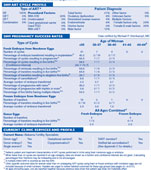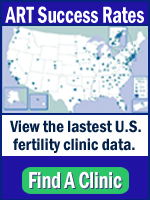Tutorial for Using the ART Report
Data from U.S. clinics that provide Assisted Reproductive Technology (ART) services to treat infertility are a rich source of information about the factors that contribute to success—the delivery of a live-born infant. The Report, and related materials on this Web site, give potential ART users an idea of their average chances of success.
Infertility: A Tutorial on the ART Report
You need the Flash plugin to view this video.
The video will help you identify and use important parts of the CDC's ART Success Rates Report including the National Summary and Fertility Clinic tables.
Learn more about the development of these videos, the experts involved, and the stories on each family.
What Information is in the ART Report?
The data for the annual reports come from fertility clinics in operation during a reporting period, normally a calendar year. These clinics provide and verify data on the outcomes of all ART cycles started in their clinics.
 Sections 1–5 provide information about success using data about all cycles performed in the United States. This helps answer questions such as—
Sections 1–5 provide information about success using data about all cycles performed in the United States. This helps answer questions such as—
- Who used ART services?
- What are the average chances of success using a specific type of ART service/procedure?
- What were the experiences of others who made the decision to use their own eggs or embryos vs. donated eggs?
- What are some of the factors that may influence success?
- Does age or type of infertility diagnosis matter?
Tables and charts along with a narrative discussion help you learn more about ART and how it may meet your need to form a family.
A separate portion of the annual report presents summary data from all clinics in the United States, followed by individual clinic reports. Clinics are listed in alphabetical order by state, then city, then clinic name.
The latest ART Success Rates Report is available online. It appears in several forms. You have the options of downloading the Report in Adobe PDF or reading directly from the Web. The interactive version allows you to select and print information about individual clinics.
Hints
- Print or “bookmark” the National Summary table for use in comparing and contrasting data and information from individual clinics.
- If using donor eggs or embryos, review Sections 1 and 4 of the report.
- If using your own fresh eggs for ART, review Sections 1 and 2 of the report.
- Clinics in large cities may have a main office and other locations in suburban areas. Often, the report combines data from all clinics and offices associated with the ART practice.
Some ART procedures use a woman’s own eggs, and others use donated eggs or embryos. Although sperm used to create an embryo also may be either from a woman’s partner or from a sperm donor, information in the report is presented according to the egg source. In some procedures, the embryos that develop are transferred back to the woman (fresh embryo transfer); in others, the embryos are frozen (cryopreserved) for transfer at a later date. The reports include data on frozen embryos that were thawed and transferred in the calendar year, not in the year in which they were preserved.
Details about Sections 1–5 of the Annual Report
Section 1: Overview
This section answers many questions, including—- Where are U.S. ART clinics located, how many ART cycles did they perform, and how many infants were born from these ART cycles?
- What types of ART cycles were used in the United States?
- How old were women who used ART in the United States?
- What types of ART cycles were used among women of different ages?
Section 2: ART Cycles Using Fresh Nondonor Eggs or Embryos
This section focuses on the use of a woman’s own eggs or embryos produced using her eggs. These are fresh rather than frozen eggs or embryos.
It answers these questions for those considering the use of fresh, nondonor eggs and embryos.
- What are the steps for an ART cycle using fresh nondonor eggs or embryos?
- Why are some ART cycles discontinued?
- How are success rates of ART measured?
- What percentage of ART cycles result in a pregnancy?
- What percentage of pregnancies result in a live birth?
- What is the risk of having a multiple-fetus pregnancy or multiple-infant live birth?
- What is the risk for preterm birth?
- What is the risk of having low-birth-weight infants?
- What are the ages of women who use ART?
- Do percentages of ART cycles that result in pregnancies, live births, and singleton live births differ among women of different ages?
- How do percentages of ART cycles that result in pregnancies, live births, and singleton live births differ for women aged 40 years or older?
- How does the risk for miscarriage differ among women of different ages?
- How does the risk for pregnancy loss vary during pregnancy (through week 24) among women of different ages?
- How does a woman’s age affect her chances of progressing through the various stages of ART?
- What are the causes of infertility among couples who use ART?
- Does the cause of infertility affect the percentage of ART cycles that result in live births?
- How many women who use ART have previously given birth?
- Do women who have previously given birth have higher percentages of ART cycles that result in live births?
- Is there a difference in percentages of ART cycles that result in live births between women with previous miscarriages and women who have never been pregnant?
- How many current ART users have undergone previous ART cycles?
- Are percentages of ART cycles that result in live births different for women using ART for the first time and women who previously used ART but did not give birth?
- What is the percentage of ART cycles that result in live births for women who have had both previous ART and previous births?
- What were the specific types of ART performed among women who used fresh nondonor eggs or embryos in that calendar year?
- What is the percentage of egg retrievals that result in live births for different types of ART procedures?
- Is intracytoplasmic sperm injection (ICSI) used only for couples diagnosed with male factor infertility?
- What is the percentage of retrievals that result in live births for couples with male factor infertility when ICSI is used?
- What is the percentage of retrievals that result in live births for couples without a diagnosis of male factor infertility when ICSI is used?
- How many embryos are transferred in an ART procedure?
- In general, is an ART cycle more likely to be successful if more embryos are transferred?
- Are percentages of transfers that result in live births affected by the number of embryos transferred for women who have more embryos available than they choose to transfer?
- How long after egg retrieval does embryo transfer occur?
- In general, is an ART cycle more likely to be successful if embryos are transferred on day 5?
- Does the number of embryos transferred differ for day 3 and day 5 embryo transfers?
- In general, how does the multiple-infant birth risk vary by the day of embryo transfer?
- For day 5 embryo transfers, are percentages of transfers that result in live births affected by the number of embryos transferred for women who have more embryos available than they choose to transfer?
- How do percentages of transfers that result in live births for women who use gestational carriers compare with women who do not use gestational carriers?
- How is clinic size related to percentages of ART cycles that result in live births?
Section 3: ART Cycles Using Frozen Nondonor Eggs or Embryos
This section focuses on cycles using embryos that were developed from the woman’s own eggs and frozen for later use. Two important questions are answered using graphics and data from clinic reporting.
- What is the percentage of transfers that result in live births and singleton live births for ART cycles using frozen nondonor embryos?
- What is the risk of having a multiple-fetus pregnancy or multiple-infant live birth from an ART cycle using frozen nondonor embryos?
Section 4: ART Cycles Using Donor Eggs
This section is useful for those considering use of donor eggs. It answers these key questions.
- Are older women undergoing ART more likely to use donor eggs or embryos?
- Do percentages of transfers that result in live births differ by age for women who used ART with donor eggs compared with women who used ART with their own eggs?
- How successful is ART when donor eggs are used?
- What is the risk of having a multiple-fetus pregnancy or multiple-infant live birth from an ART cycle using fresh donor eggs?
- How do percentages of transfers that result in live births differ for ART cycles between women who use frozen donor embryos and those who use fresh donor embryos?
Section 5: ART Trends
In this section you will find answer to questions about—
- Is the use of ART increasing?
- Are there changes in the types of ART cycles performed among women who used fresh or frozen nondonor eggs or embryos?
- What are the changes in the types of ART cycles performed among women who used fresh or frozen donor eggs or embryos?
- Have there been changes in percentages of transfers that resulted in live births among women who used fresh or frozen nondonor eggs or embryos?
- Have there been changes in percentages of transfers that resulted in live births among women who used fresh or frozen donor eggs or embryos?
- Have there been changes in percentages of transfers that resulted in singleton live births among women who used fresh or frozen nondonor eggs or embryos?
- Have there been changes in percentages of transfers that resulted in singleton live births among women who used fresh or frozen donor eggs or embryos?
- Have there been changes in percentages of transfers that resulted in live births for all ART patients or only for those in particular age groups?
- Have there been changes in percentages of transfers that resulted in singleton live births for all ART patients or only for those in particular age groups?
- Has the number of embryos transferred changed in fresh, nondonor cycles?
- Has the number of embryos transferred changed in fresh, nondonor cycles for women younger than age 35 who have more embryos available than they choose to transfer?
- Have there been changes in percentages of transfers that resulted in live births, by number of embryos transferred?
- Have there been changes in percentages of transfers that resulted in live births for women younger than age 35 who have more embryos available than they choose to transfer?
- Have percentages of multiple-infant live births changed?
- Have percentages of multiple-infant live births for ART cycles using fresh nondonor eggs or embryos changed in particular age groups?
Contact Us:
- Centers for Disease Control and Prevention
1600 Clifton Rd
Atlanta, GA 30333 - 800-CDC-INFO
(800-232-4636)
TTY: (888) 232-6348 - New Hours of Operation
8am-8pm ET/Monday-Friday
Closed Holidays - cdcinfo@cdc.gov



